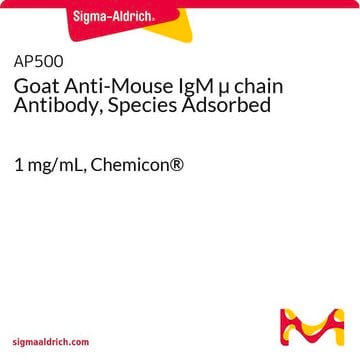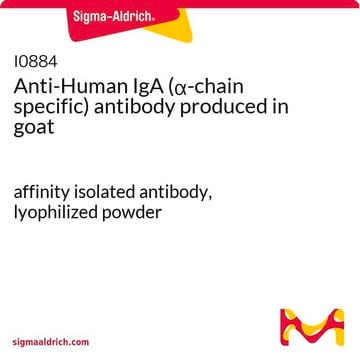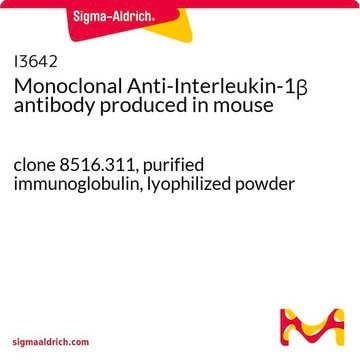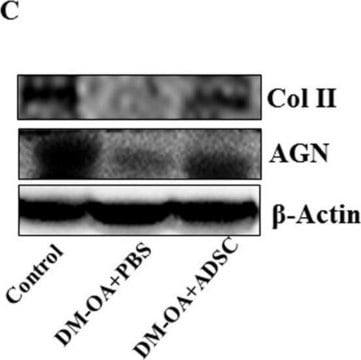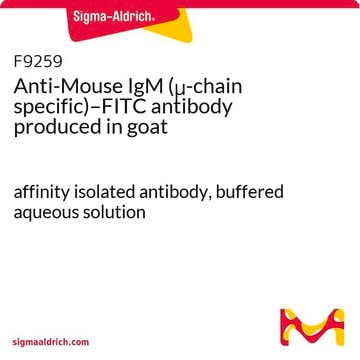おすすめの製品
特異性
Based on immunoelectrophoresis, the antibody reacts with the heavy chain portion of IgM. No reactivity with IgG or non-immunoglobulin serum proteins was detected, but cross reactivity with IgM from other species may be detected.
F/P RATIO:
9.0 mg/mg; 3.4 moles FITC per mole IgG
F/P RATIO:
9.0 mg/mg; 3.4 moles FITC per mole IgG
アプリケーション
Research Category
二次抗体及びコントロール抗体
二次抗体及びコントロール抗体
Research Sub Category
フラグメント特異的二次抗体
フラグメント特異的二次抗体
Goat anti-Mouse IgM Antibody, μ chain, FITC conjugate detects level of Mouse IgM & has been published & validated for use in IF.
物理的形状
ImmunoAffinity Purified
Freeze dried powder. Leyofilized from liquid containing 0.01M sodium phosphate, pH7.6, 0.25M sodium chloride, 15 mg/mL bovine serum albumin, and 0.05% sodium azide.
RECONSTITUTION:
Reconstitute in 1mL deionized water.
RECONSTITUTION:
Reconstitute in 1mL deionized water.
保管および安定性
Maintain lyophilized product at 2-8°C for up to 12 months. After reconstitution the product is stable for several weeks at 2-8°C as an undiluted liquid. For extended storage after reconstitution, add an equal volume of glycerol to make a final concentration of 50% glycerol followed by storage at -20°C in undiluted aliquots for up to 12 months. Please note the concentration of protein (and buffer salts) will decrease to one-half of the original after the addition of glycerol. Avoid repeated freeze/thaw cycles.
法的情報
CHEMICON is a registered trademark of Merck KGaA, Darmstadt, Germany
免責事項
Unless otherwise stated in our catalog or other company documentation accompanying the product(s), our products are intended for research use only and are not to be used for any other purpose, which includes but is not limited to, unauthorized commercial uses, in vitro diagnostic uses, ex vivo or in vivo therapeutic uses or any type of consumption or application to humans or animals.
Not finding the right product?
Try our 製品選択ツール.
適用法令
試験研究用途を考慮した関連法令を主に挙げております。化学物質以外については、一部の情報のみ提供しています。 製品を安全かつ合法的に使用することは、使用者の義務です。最新情報により修正される場合があります。WEBの反映には時間を要することがあるため、適宜SDSをご参照ください。
毒物及び劇物取締法
毒物
Jan Code
AP128F:
試験成績書(COA)
製品のロット番号・バッチ番号を入力して、試験成績書(COA) を検索できます。ロット番号・バッチ番号は、製品ラベルに「Lot」または「Batch」に続いて記載されています。
Ying Peng et al.
OncoTargets and therapy, 13, 8677-8689 (2020-09-29)
Thomsen-Friedenreich antibody (TF-Ab) is a specific antibody against the Thomsen-Friedenreich antigen (TF-Ag). At present, studies on a number of other tumors have shown that TF-Ab can effectively inhibit metastasis and induce apoptosis in tumor cells. However, the role of TF-Ab
Francesca Cialdai et al.
Cellular and molecular life sciences : CMLS, 78(23), 7795-7812 (2021-10-30)
Astronauts on board the International Space Station (ISS) are exposed to the damaging effects of microgravity and cosmic radiation. One of the most critical and sensitive districts of an organism is the eye, particularly the retina, and > 50% of astronauts develop
Katsuyoshi Kumagai et al.
Experimental animals, 66(2), 125-136 (2016-11-29)
Targeted mutant mice generated on a C57BL/6 background are powerful tools for analysis of the biological functions of genes, and gene targeting technologies using mouse embryonic stem (ES) cells have been used to generate such mice. Recently, a bacterial artificial
Jamie L Marshall et al.
Human molecular genetics, 21(20), 4378-4393 (2012-07-17)
Sarcospan (SSPN) is a core component of the major adhesion complexes in skeletal muscle, the dystrophin- and utrophin (Utr)-glycoprotein complexes (DGC and UGC). We performed a rigorous analysis of SSPN-null mice and discovered that loss of SSPN decreased DGC and
M S Yoon et al.
European journal of pain (London, England), 22(9), 1691-1700 (2018-06-05)
Neuropathic pain is associated with abnormal sensitivity of the central nervous system. Although the mechanism underlying the development of sensitization remains to be fully elucidated, recent studies have reported that neuroplastic changes in the pain circuitry may be involved in
ライフサイエンス、有機合成、材料科学、クロマトグラフィー、分析など、あらゆる分野の研究に経験のあるメンバーがおります。.
製品に関するお問い合わせはこちら(テクニカルサービス)